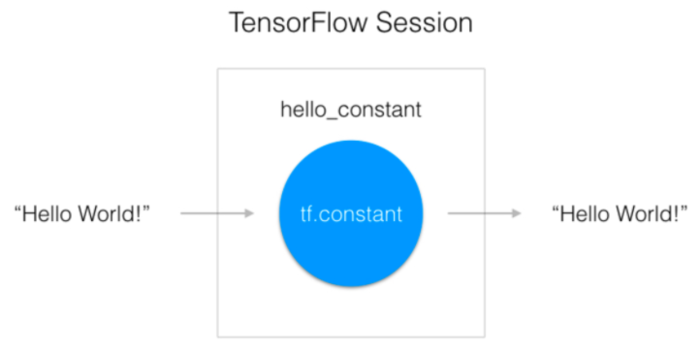作者:miss文女1977 | 来源:互联网 | 2023-09-08 16:21
安装好TensorFlow之后,开一个python环境,就可以开始运行和使用TensorFlow了。先给一个实例,#先导入TensorFlowimporttensorflowast
安装好TensorFlow之后,开一个python环境,就可以开始运行和使用TensorFlow了。
先给一个实例,
#先导入TensorFlow
import tensorflow as tf
hello_cOnstant= tf.constant('Hello World!') # Create TensorFlow object called hello_constant
with tf.Session() as sess:
output = sess.run(hello_constant) # Run the tf.constant operation in the session
print(output)
也许有人奇怪,为什么不直接输出“Hello World!”呢,这个看起来很麻烦,是吗?其实不是的
1.Tensor是什么?
在 TensorFlow 中,数据不是以整数,浮点数或者字符串形式存在的,而是被封装在一个叫做 tensor 的对象中。Tensor是张量的意思,张量包含了0到任意维度的量,其中,0维的叫做常数,1维的叫做向量,二维叫做矩阵,多维度的就直接叫张量量。在 hello_cOnstant= tf.constant(‘Hello World!’) 代码中,hello_constant是一个 0 维度的字符串 tensor,tensors 还有很多不同大小:
# tensor1 是一个0维的 int32 tensor
tensor1 = tf.constant(1234)
# tensor2 是一个1维的 int32 tensor
tensor2 = tf.constant([123,456,789])
# tensor3 是一个二维的 int32 tensor
tensor3 = tf.constant([ [123,456,789], [222,333,444] ])
2.Session是Tensorflow中的一个重要概念
Tensorflow中的所有计算都构建在一张计算图中,这是一种对数学运算过程的可视化方法。就像刚才的代码:
with tf.Session() as sess:
output = sess.run(hello_constant)

这个session就是负责让这个图运算起来,session的主要任务就是负责分配GPU或者CPU的。
3.tf.placeholder()
前面代码中出现了tf.constant(‘Hello World!’),这个tf.constant是用来定义常量的,其值是不变的,但是如果你需要用到一个变量怎么办呢?
这个时候就需要用到tf.placeholder() 和 feed_dict了。
先给代码
x = tf.placeholder(tf.string)
with tf.Session() as sess:
output = sess.run(x, feed_dict={x: 'Hello World'})
tf.placeholder表示一个占位符,至于是什么类型,看自己定义了,这里定义的是tf.string类型,然后呢,在session开始run以前,也就死这个图开始计算以前,就使用feed_dict将对应的值传入x,也就是这个占位符。
同样的feed_dict可以设置多个tensor
x = tf.placeholder(tf.string)
y = tf.placeholder(tf.int32)
z = tf.placeholder(tf.float32)
with tf.Session() as sess:
output = sess.run(x, feed_dict={x: 'Test String', y: 123, z: 45.67})
但是需要注意的是,使用feed_dict设置tensor的时候,需要你给出的值类型与占位符定义的类型相同。
#coding=utf-8
import tensorflow as tf
import os
os.environ['TF_CPP_MIN_LOG_LEVEL'] = '2' #忽略烦人的警告
#import numpy;
hello_cOnstant=tf.constant("Hello Ryan!")
tensor1 = tf.constant(1234)
tensor2 = tf.constant([123,456,789])
tensor3 = tf.constant([ [123,456,789], [222,333,444] ])
x = tf.placeholder(tf.string)
y = tf.placeholder(tf.int32)
z = tf.placeholder(tf.float32)
with tf.Session() as sess:
output=sess.run(hello_constant)
print(output)
output1=sess.run(tensor1)
print(output1)
output2=sess.run(tensor2)
print(output2)
output3=sess.run(tensor3)
print(output3)
output4=sess.run(x,feed_dict={x:'Hello World'})
print(output4)
output5=sess.run(x,feed_dict={x:'Hello zhu',y:123,z:55.5555})
print(output5)
$ python zhuyr.py
b'Hello Ryan!'
1234
[123 456 789]
[[123 456 789]
[222 333 444]]
Hello World
Hello zhu
(tensorflow)